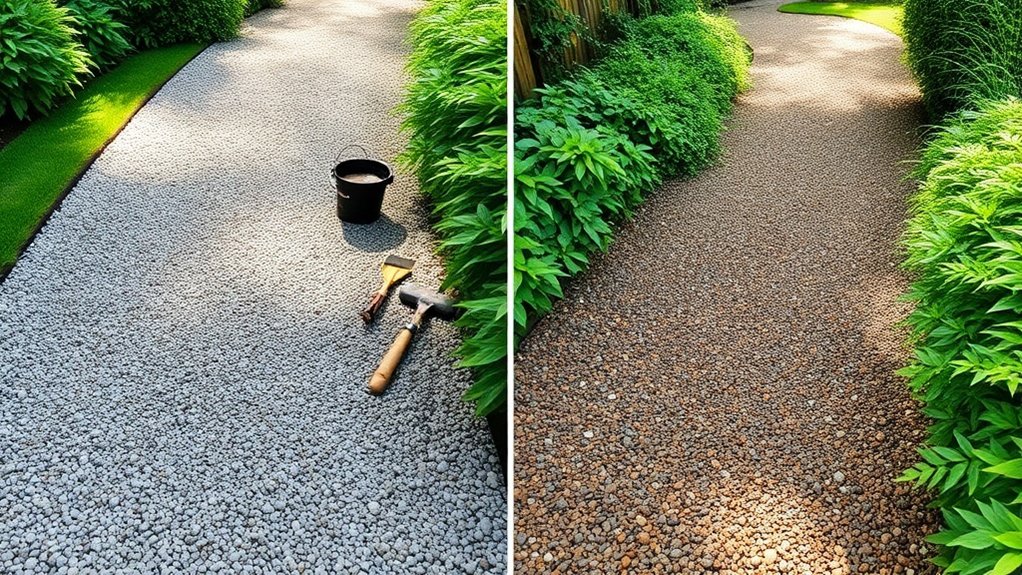To transition from DIY to professional resin-bound gravel installation, begin by mastering the essentials, such as assessing substrates and preparing surfaces. Invest in specialised equipment like forced action mixers to ensure proper blending. Always adhere to manufacturer specifications during mixing and application for a uniform finish. Familiarise yourself with advanced techniques and be prepared to troubleshoot common issues, such as drainage problems. By refining these skills, you’ll deliver high-quality results that meet professional standards. Keep learning to continuously improve your expertise.
Key Takeaways
- Invest in professional-grade equipment like forced action mixers and helical-bladed paddle mixers to ensure consistent results and high-quality finishes.
- Learn the ins and outs of substrate preparation and installation techniques. A solid, stable base is crucial for meeting load-bearing requirements.
- Use UV-resistant resins and top-notch aggregates to create durable and visually appealing surfaces that stand the test of time.
- Familiarise yourself with quality control measures to address common installation challenges, such as loose stones and drainage issues.
- Always prioritise safety by using personal protective equipment (PPE) and ensuring proper ventilation during installations to protect both yourself and your team.
Understanding the Basics of Resin-Bound Gravel
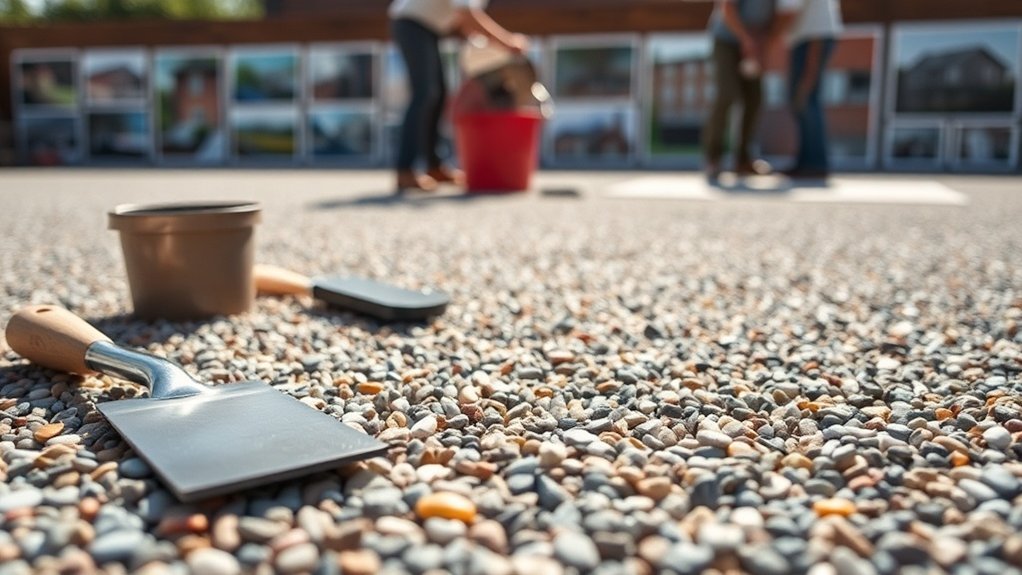
To understand resin-bound gravel, it’s important to know its composition and properties. This innovative surface combines selected aggregates—such as gravel, crushed stone, or marble—with UV-resistant, non-yellowing resin.
In a forced action mixer, the aggregates blend evenly with the resin, ensuring a consistent finish. The permeable surface allows for effective water drainage, reducing runoff and the risk of flooding. This material contributes to sustainable drainage solutions by managing stormwater efficiently and preventing floods, while also helping to replenish groundwater in urban settings.
You can also customise the aggregate and resin types to fit your aesthetic preferences. This flexibility, along with its durability and low maintenance needs, makes resin-bound gravel a popular choice for driveways, patios, and pathways.
Knowing these basics will help you appreciate the benefits of professional installation.
Assessing Substrate and Surface Preparation
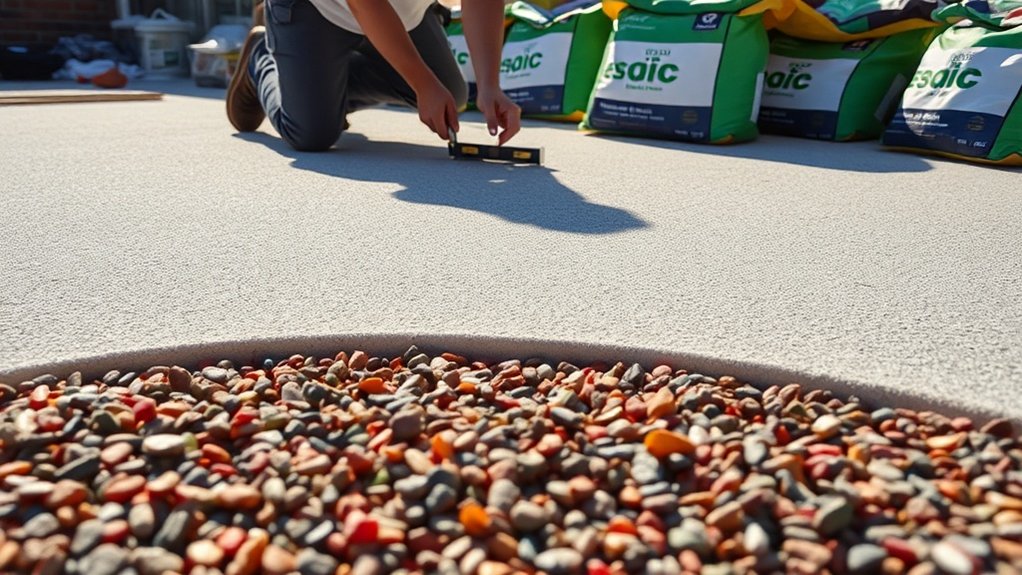
To ensure a successful resin-bound gravel installation, it’s vital to assess the substrate and prepare the surface properly. Pay attention to the following aspects:
- Substrate Assessment: Ensure the substrate is sound, stable, and solid—typically concrete or asphalt.
- Surface Cleaning: Clean the base thoroughly to remove dust, debris, and any contaminants that could hinder bonding. Additionally, the surface must be bone dry to prevent disruptions in the resin curing process.
- Surface Flatness: Check that the surface is flat and level, with height variations no greater than 4mm to avoid water pooling. It’s important to note that resin bound gravel offers excellent water drainage capabilities that comply with Sustainable Urban Drainage Systems (SUDS) regulations.
- Load-Bearing Capacity: Consider the expected traffic and confirm the subbase can handle the load without risk of failure, as a properly compacted base material is critical for long-lasting performance.
These steps are crucial for achieving optimal adhesion and durability in your resin-bound gravel installation, leading to a long-lasting finish.
Key Differences Between DIY and Professional Installation
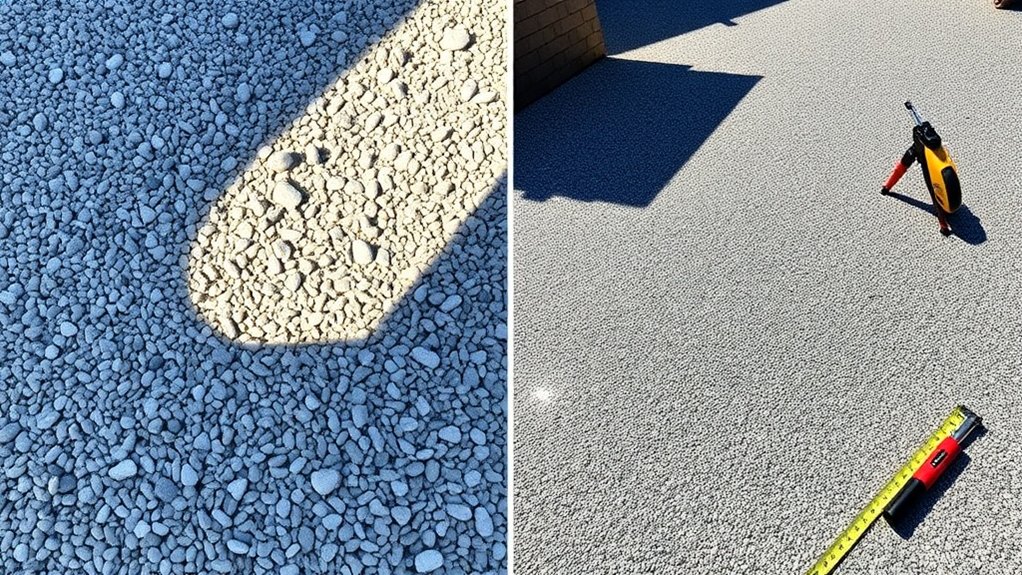
When it comes to installing resin-bound gravel, the skills and experience of professionals are crucial for achieving the best results. Unlike DIY methods that typically use basic tools and materials, professional installations employ specialised equipment and high-quality materials, ensuring both durability and visual appeal. This difference not only impacts the installation process but also affects the long-term performance and lifespan of the surface. For instance, while a DIY job might look good initially, it may not withstand the test of time like a professionally installed surface would. Additionally, professional installations ensure proper base preparation, which is crucial for the stability and durability of the surface. Moreover, professionals understand material safety compliance and adhere to strict guidelines, minimizing risks during installation.
Expertise and Experience
Many homeowners might think about a DIY approach to resin-bound gravel installation, but hiring professional installers is crucial for achieving a durable and attractive surface.
Here are some reasons why professionals stand out:
- Expert Knowledge: Professionals can evaluate the stability of the ground and ensure compliance with Sustainable Urban Drainage Systems (SUDS) for lasting results.
- Installation Precision: They use specialised tools for consistent mixing of resin and aggregates, resulting in a smooth finish that DIY methods often fail to achieve.
- Project Management: Experienced teams can foresee potential challenges, ensuring the project is completed on time and meets high quality standards.
- Experience: Professionals are adept at handling varying weather conditions and site complexities, minimising the risk of premature issues.
Investing in professional installation not only improves the look of your space but also guarantees its long-term performance.
Equipment and Materials
Professional resin-bound gravel installations stand out due to the use of advanced equipment and high-quality materials. The right equipment is crucial; professionals use forced action mixers for consistent blending of resin and aggregate, alongside specialised tools for precise finishing.
Compaction equipment is commonly employed to ensure a stable substrate, and curing equipment may be used to speed up the process in colder weather.
Material quality is equally important; professionals opt for premium-grade resins that offer durability and select aggregates to meet specific aesthetic needs. They also incorporate performance-enhancing additives and suitable adhesives for strong bonding.
This meticulous focus on equipment and materials ensures a superior finish and long-lasting satisfaction.
Advanced Mixing Techniques and Equipment
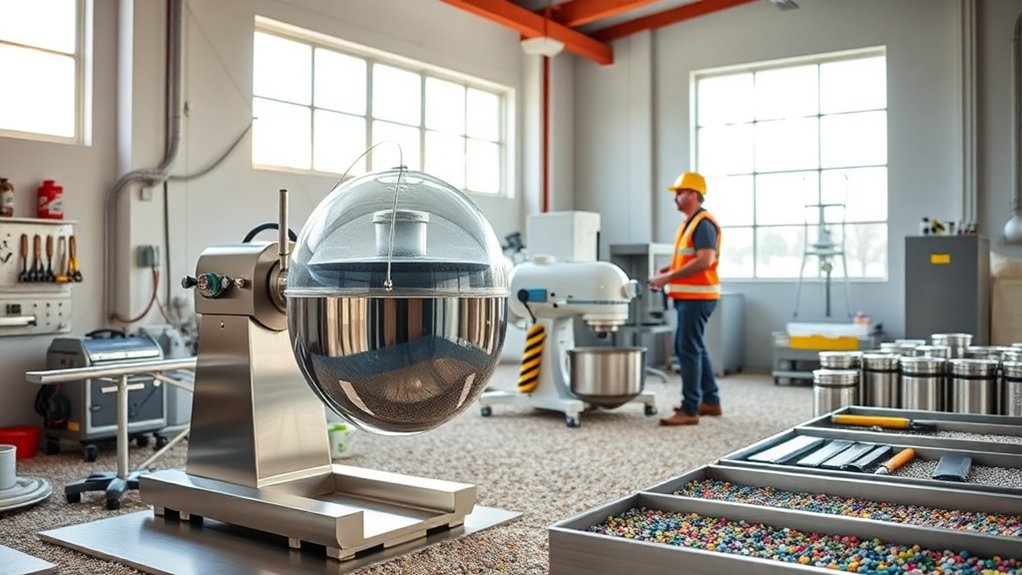
Achieving the best results in resin-bound gravel installation relies on using advanced mixing techniques and the right equipment. Selecting the appropriate tools is crucial for maintaining consistent quality.
Here are some essential mixing methods to follow:
- Use forced action mixers to ensure thorough blending of resin and aggregate; traditional concrete mixers aren’t suitable.
- Opt for high-torque, helical-bladed paddle mixers for a gentle initial mix of Part A resin before incorporating Part B.
- Keep an eye on digital timers to limit mixing to under 5 minutes, which helps achieve a uniform colour and proper cure.
- Pre-mix aggregates thoroughly to avoid dust contamination and preserve surface integrity.
Troubleshooting Common Installation Challenges
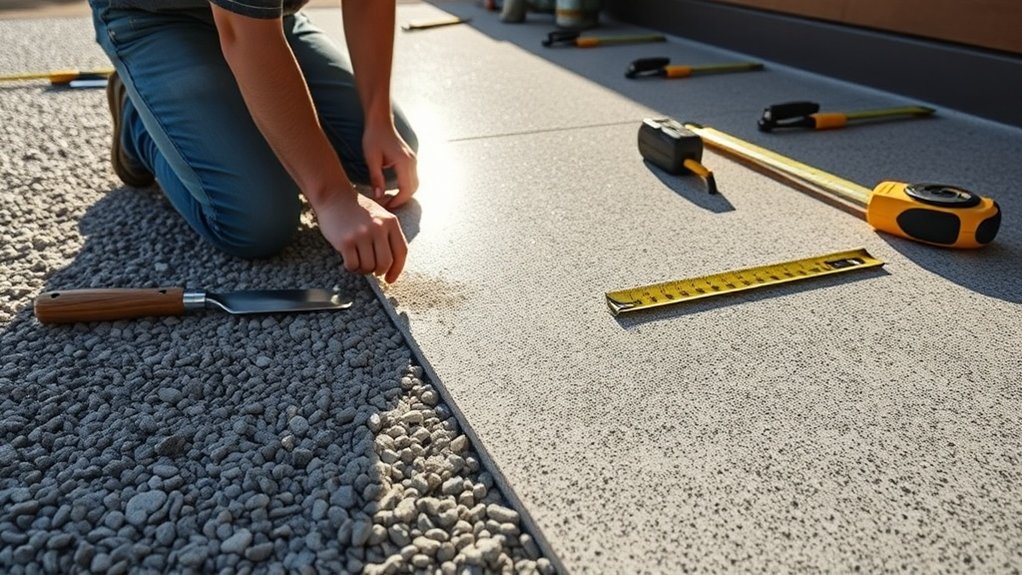
Installing resin-bound gravel can pose several challenges that affect the quality and durability of your project.
One common issue is loose stones, which may occur if the resin doesn’t bond properly with the aggregate. If this happens, you’ll need to remove the loose stones and reapply the resin using the correct type of aggregate to achieve a smooth finish.
Discolouration, particularly with lighter aggregates under UV exposure, is another concern. This often results from using non-UV-stable resins. To keep your installation looking its best, opt for UV-resistant resins.
Drainage problems can also arise from inadequate sub-base installation, leading to water pooling. Make sure to install a proper sub-base to prevent this.
In colder weather, it’s important to use freeze-resistant resins and ensure your foundations are deep enough to avoid frost damage.
Essential Tools for Professional-Grade Results

To achieve professional results in resin-bound gravel installation, it’s essential to have the right mixing equipment and surface preparation tools.
Using forced action mixers and accurate measuring tools ensures the resin has the right consistency and adheres effectively, providing a strong foundation for your work.
Professional Mixing Equipment
The right professional mixing equipment is crucial for achieving top-notch resin-bound gravel installations. To ensure excellent results, consider the following:
- Forced Action Mixers: These mixers deliver thorough and consistent mixing, preventing any dry or resin-heavy patches.
- Paddle Mixers: A 110V drill fitted with a spiral paddle works well to blend resin and hardener, helping to reduce air bubbles.
- Mixer Capacity: A 120L model is suitable for most projects; however, larger capacities are advisable for more extensive jobs.
- Equipment Maintenance: Regularly cleaning your mixers and using quick-release drums will improve workflow and extend the life of your equipment.
Surface Preparation Essentials
Successful resin-bound gravel installations rely on precise surface preparation, which is crucial for achieving a durable and attractive finish.
Start by thoroughly cleaning the surface; this means removing all loose stones, dirt, and organic matter to ensure proper bonding. A power wash is effective here, but make sure the area is completely dry before moving on.
Next, focus on base compaction. Excavate to the correct depth and use a mechanical compactor to compress the sub-base and eliminate air pockets. For strength and drainage, use MOT type 1 or 20mm crushed stone.
Once the base is level, install edge restraints to prevent lateral movement and ensure stability.
Finally, conduct a thorough inspection of the surface to check for any damage or blockages before applying the resin.
Frequently Asked Questions
What Types of Resin Are Best for Different Applications?
For driveways and robust surfaces, opt for UV-stable polyurethane for its durability. In commercial environments, epoxy types provide superior strength. For pathways, standard polyurethane is ideal for its aesthetics and permeability, while flexible polyurethane works well for sports surfaces.
How Long Does Resin-Bound Gravel Typically Last?
Resin-bound gravel generally lasts between 15 to 30 years. To ensure it endures, choose high-quality materials and have it installed by professionals. Regular maintenance, such as resealing every five years, will help keep it looking smart.
Can Resin-Bound Surfaces Be Repaired if Damaged?
Yes, resin-bound surfaces can be repaired using effective techniques. For the best results, make sure to clean the area thoroughly, mix the resin properly, and allow sufficient curing time. This will help restore both the integrity and appearance of the surface. For example, if you notice a crack or discolouration, addressing it promptly with the right methods can prevent further damage.
What Environmental Factors Affect Resin Curing Time?
Consider a garden: temperature and humidity play crucial roles in resin curing. Extreme heat or cold can either speed up or slow down the process, while high humidity can lead to complications. Striking the right balance is essential for achieving the best results.
How Do I Choose the Right Aggregate for My Project?
To select the right aggregate for your project, consider key characteristics such as size, durability, and permeability. For example, larger aggregates may be suitable for drainage projects, while finer aggregates work well for concrete mixes. Don’t forget to explore colour variations to ensure aesthetic appeal and harmony with surrounding elements for a cohesive design.
Conclusion
Transitioning from DIY to professional resin-bound gravel installation involves more than just improving your skills; it’s about understanding the finer details of the process. For instance, even a small change in mixing ratios can significantly affect the durability of your installation. By refining your techniques and using the right tools, you can produce results that not only meet but surpass industry standards. Embrace these insights to elevate your work to a level that reflects true professionalism and craftsmanship.
